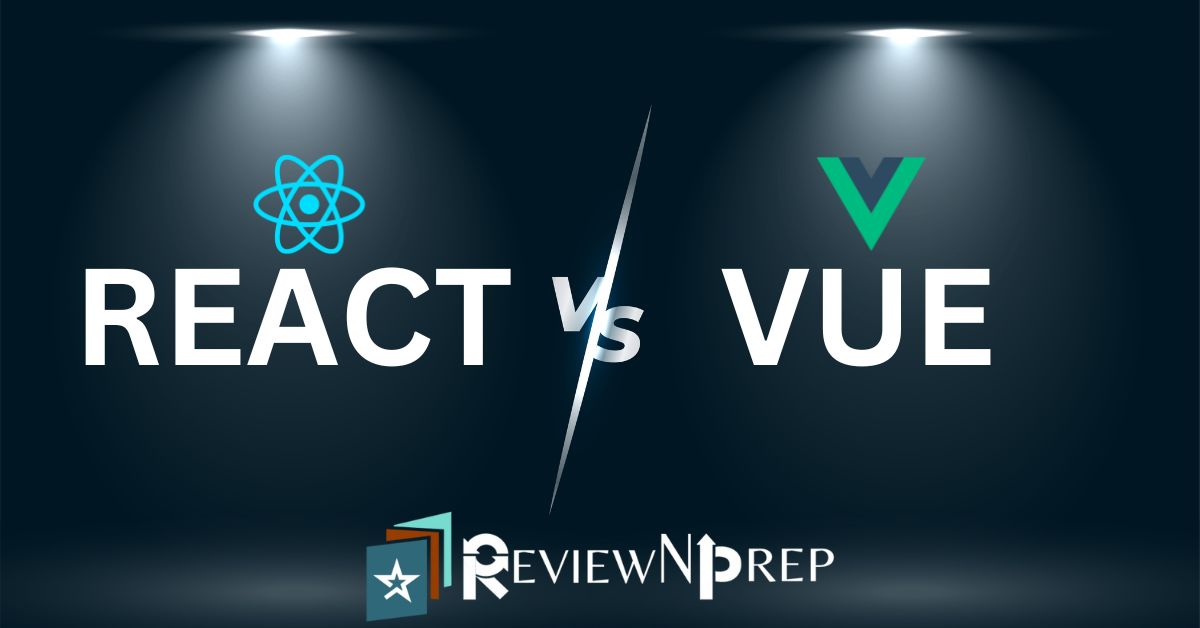|
|
Javascript programming language has been around for a long time and has evolved since its early days. Some of the popular javascript frameworks include Angular, Backbone, Svelte, Ember, Preact, React and Vue.
When it comes to choosing a front-end JavaScript framework, two names that immediately come to mind are Vue and React. Both Vue and React are popular and widely used front-end development frameworks for building user interfaces, and they have their unique strengths and weaknesses.
React has a much larger user base and community support, and many popular websites and applications are built with React, such as Facebook, Instagram, Airbnb, and Netflix. However, this does not necessarily mean that React is always the better choice than Vue. Vue has its own strengths, including its simplicity and ease of use, and it may be a better fit for certain projects or teams. Some popular companies using Vue tech stack include Alibaba, GitLab, 9GAG, Xiaomi and Louis Vuitton to name a few.
In this blog post, we’ll compare Vue and React, and provide examples of how each framework works in practice.
Table of Contents
Vue
Vue is a lightweight framework for building user interfaces. It was developed by Evan You in 2014 and has since gained a lot of popularity due to its simplicity and ease of use. Vue is labelled as a progressive framework that emphasizes declarative rendering and component-based architecture, making it easy to build complex UIs with reusable components.
Vue is easy to learn and use, and its documentation is considered one of the best among all the front-end frameworks. Vue is also known for its excellent performance, as it is lightweight and optimized for fast rendering. Here’s an example of a simple Vue component that displays a message:
<template>
<div>
<h1>{{ message }}</h1>
</div>
</template>
<script>
export default {
data() {
return {
message: 'Hello, Vue!'
}
}
}
</script>In this example, we define a Vue component with a template and a script section. The template section contains the HTML code that will be rendered, and the script section defines the component’s behavior. The component displays a message ‘Hello, Vue!’ in an H1 tag.
React
React is a JavaScript library for building user interfaces. It was developed by Facebook in 2011 and is now one of the most popular front-end libraries used by developers. React uses a virtual DOM to efficiently update and render the UI, which makes it fast and responsive.
React is known for its simplicity and flexibility, making it easy to integrate with other libraries and frameworks. React also has an extensive ecosystem of tools and plugins that makes it easy to build complex UIs and single-page applications.
Here’s an example of a simple React component that displays a message:
import React from 'react';
function App() {
const message = 'Hello, React!';
return (
<div>
<h1>{message}</h1>
</div>
);
}
export default App;
In this example, we define a React component using a function. The component returns a JSX element that displays a message ‘Hello, React!’ in an H1 tag.
Related: Check out this blog on how to become a Full Stack Developer
Vue vs React
Both Vue and React have a ton of similarities in the sense that both are fast, can scale easily and easy to debug. Let us look at some differences between React and Vue.
Usage Popularity
React is undoubtedly the most popular JavaScript framework among coders, surpassing even its elder sibling – Angular. React is better suited to code complex applications for large-scale projects.
VueJS has experienced an astonishing surge in both usage and recognition over the past few years; it has become an indispensable asset for developers, designers and entrepreneurs alike. While both frameworks have their devotees, Vue continues to climb towards uncharted heights!
Generally, Vue app can be developed with less coding than React, simplifying the development process, saving both time and money.
Performance
React uses a virtual DOM (Document Object Model) which updates only the necessary parts of the UI that need to be changed, resulting in a more efficient and faster rendering process. Additionally, React’s one-way data flow makes it easier to optimize performance by minimizing unnecessary re-renders.
Vue also uses a virtual DOM and provides a reactivity system that allows components to update only when their underlying data changes. Vue also has a built-in template compiler that optimizes the rendering process by converting templates to render functions.
In terms of bundle size, Vue’s core library is smaller than React’s, which can be an advantage for performance. However, React’s ecosystem has a larger selection of third-party libraries and tools that can help optimize performance.
Templates
One of the biggest differences between Vue and React is the way they handle templates. Vue uses templates to define the UI, while React uses JSX, a syntax extension for JavaScript that allows you to write HTML-like code in your JavaScript files.
Syntax
Vue’s template syntax is easier to read and understand, especially for beginners. However, React’s JSX syntax offers more flexibility and control over the UI, allowing you to easily create dynamic and complex UIs.
If you’re looking for simplicity and prefer to work with convention over configuration, creating components in Vue might be a better fit for you than creating DOM elements within React. With a single line of JavaScript, your app could have dynamic and interactive UI elements at its disposal!
State Management
Another difference between Vue and React is the way they handle state management. Vue has a built-in state management system called Vuex, while React relies on external libraries like Redux or Context API to manage state.
Vue’s state management system is easier to use and requires less boilerplate code, while React’s external libraries offer more advanced features and better scalability.
Ultimately, the choice between React and Vue depends on the specific requirements and constraints of the project, as well as the skills and preferences of the development team.
Mobile Apps
React Native is a popular framework for building native mobile applications using React. React Native allows you to write code once and deploy it on both iOS and Android platforms. React Native provides a rich set of native components that can be used to build UIs, and it has a large and active community of developers and contributors.
Vue, on the other hand, has a few options for building mobile applications. Vue Native is a framework for building mobile apps using Vue, but it is not as widely used as React Native. Another option is to use Quasar, which is a UI framework that includes support for building mobile apps using Vue.
In terms of adoption for mobile devices, React Native has a larger community and more resources available than Vue Native. This means that React Native is a more popular choice for building mobile applications. However, Vue can still be a good choice for mobile development, especially if you already have experience with Vue or prefer its syntax and approach.
CLI
The Vue CLI is a command-line tool for scaffolding Vue.js projects. It provides a set of project templates and plugins that can be used to create new Vue projects or add functionality to existing ones. The Vue CLI also includes a development server and build system, which can be used to preview and optimize the application.
React, on the other hand, has the Create React App CLI, which is a tool for creating React projects quickly and easily. Create React App generates a basic project structure with all the necessary configurations and dependencies. The tool includes a development server and build system, similar to Vue CLI.
Core Library and Extensions
Vue’s core library includes features such as the Vue instance, templates, components, directives, and reactive data binding. Vue also has a set of official libraries and plugins that can be used to extend its functionality, including Vuex for state management, Vue Router for routing, and Vue CLI for project scaffolding and configuration.
React’s core library includes features such as components, JSX, virtual DOM, and state management. React also has a rich ecosystem of third-party libraries and tools that can be used to extend its capabilities, such as React Router for routing, Redux for state management, and Next.js for server-side rendering.
When it comes to comparing Vue’s core library and extensions with React’s, it’s worth noting that Vue’s core library includes more out-of-the-box features than React’s. This can make Vue a bit easier to work with for beginners, as they can get started with basic functionality quickly. On the other hand, React’s focus on simplicity and modularity means that it has a larger ecosystem of third-party libraries and tools that can be used to customize and extend its functionality.
SEO
React uses server-side rendering (SSR) to render the initial HTML content on the server before sending it to the client’s browser. This approach allows search engine bots to crawl and index the content more easily, which can improve SEO. Additionally, React has several SEO-friendly libraries and tools, such as React Helmet, which allows developers to control the metadata and tags that are important for SEO.
Vue also supports server-side rendering, which can help with SEO by allowing search engines to index the content more easily. However, Vue’s server-side rendering is not as mature as React’s, and it may require more effort to set up and maintain. Vue also has several SEO-friendly libraries and tools, such as Vue Meta, which allows developers to control the metadata and tags for each page.
Pick One and Master It!
Vue is often considered to be easier to learn and use than React. This is partly because of Vue’s simpler syntax and template-based approach. Vue’s templates allow developers to write HTML-like code, which makes it easier to understand and visualize the application’s structure and functionality. Additionally, Vue’s documentation is known for being very clear and easy to follow, which can help new users get up to speed quickly. As per Salary.com, the Vue Js Developer salary range is from $76,301 to $110,617, and the average Vue Js Developer salary is $91,486/year in the United States.
React, on the other hand, can be a bit more challenging to learn initially because it requires understanding some more advanced concepts such as JSX and state management. JSX is a syntax extension to JavaScript that allows developers to write HTML-like code within JavaScript, which can be confusing for developers who are used to writing HTML and JavaScript separately. State management, which is an essential concept in React, can also be challenging for new users to understand. As per Talent.com, the average React js developer salary in the USA is $119,996 per year or $57.69 per hour. Entry level positions start at $101,117 per year while most experienced developers make up to $150,000 per year.
Learning curve for Vue is not as steep as React. That being said, both Vue and React have strong communities and active documentation, so developers can easily find resources and support to help them learn and use the frameworks. Ultimately, the choice between Vue and React depends on your specific needs and preferences, and both frameworks are accessible to developers with different levels of experience.
Conclusion
Vue and React are both excellent front-end frameworks for building user interfaces. Vue is known for its simplicity, ease of use, and excellent performance, while React is known for its flexibility, scalability, and extensive ecosystem.
Ultimately, the choice between Vue and React depends on your specific needs, preferences and project requirements. If you’re a beginner or need to build a simple UI, Vue may be the best choice for you. If you need more flexibility and control
Further Reading:
Increase your productivity as a developer and stay at the top of your game.
The 5 Best Programming Languages That Will Help You Become a Cloud Developer

